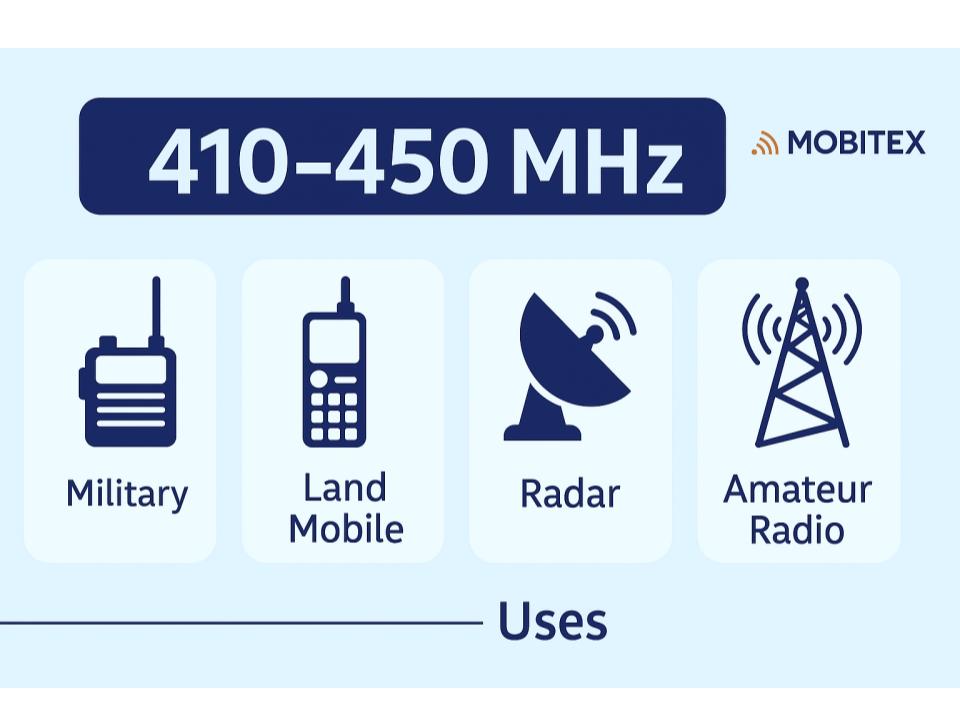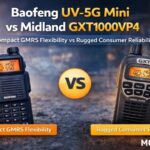Frequency
433 MHz
Range
431–440 MHz
Band Group
UHF (300–1000 MHz)
🌐 Summary
The 433 MHz allocation is part of the UHF (300–1000 MHz) spectrum. This range is used worldwide for critical applications that keep our communications and infrastructure running smoothly. On this page we highlight how each band is applied in real systems, from regulatory assignments to everyday devices. Our goal is to make spectrum data clear and practical for engineers, regulators, and enthusiasts alike.
Key uses of this band include: 433 MHz: Amateur repeaters, satellites, EME; Short‑range devices (433 MHz band); Amateur radios, PMR, IoT SRD (433 MHz); garage door remotes, car key-fobs, remote start; tire pressure telemetry; LPWAN sensors/meters/trackers.
Includes 433.05–434.79 MHz SRD/ISM in many countries (433.92 MHz center) used for keyfobs/IoT/LoRa.

🔍 Explore the full RF Spectrum database
📡 Band & Geometry key
| Field | Value |
|---|---|
| Wavelength (m) | 0.693 |
| Waveforms | – |
| Antenna Form Factor (Typical) | ¼-wave ≈ 17.3 cm |
| Band Family | Amateur/CB |
| Band | Amateur 70 cm band |
| Primary Common Name | Amateur service (70 cm) |
| FSPL @ 1 km [dB] | 85.169757927067 |
| FSPL @ 10 km [dB] | 105.16975792707 |
| Fresnel Radius @ 1 km (m) | 13.16054710109 |
| Band Group | UHF (300–1000 MHz) |
| Tax Band Family | UHF |
| Tax Band Class | UHF LMR/SRD/Amateur (410–450) |
🧩 Applications & Usage
| Field | Value |
|---|---|
| Primary Application | Amateur repeaters, satellites, EME |
| Lower Neighbor Use | UHF (Land mobile/Fixed) |
| Upper Neighbor Use | UHF (Land mobile + Amateur secondary) |
| Typical Services Devices | Short‑range devices (433 MHz band) |
| Market Common Devices | Amateur radios, PMR, IoT SRD (433 MHz) |
| Refarming Use | No |
| Device Ecosystem Size | Low (<100 models) |
| Device Hotspots (MHz) | 315, 390, 433.92; 315, 433.92; 433.92 |
| Device Category | Garage Door Opener; RKE/Key-Fob; Remote Starter; TPMS; LoRa / LoRaWAN |
| Typical Use Cases | garage door remotes, car key-fobs, remote start; tire pressure telemetry; LPWAN sensors/meters/trackers |
| Modulation (Device) | OOK/ASK; 2-FSK/FSK (varies); LoRa (CSS) |
| Channel Width (Device) [kHz] | ~10–100; ~25–100; 125–500 |
| Device Region Profiles | US: 315/390; EU: 433.92; Other: 433.92; US: 315; EU: 433.92; EU: 868; US: 902–928; AU/NZ: 915–928; AS923 variants |
| Per-Region EIRP Or Duty (Device) | Short bursts only; low EIRP; region-specific limits; Very low EIRP; bursty duty cycle; EU ≤14 dBm; US up to 30 dBm class (gateway) |
| Allocation Relevance (Device) | SRD/ISM usage permitted for short-range remotes; SRD/ISM; vehicle telemetry; ISM LPWAN allocations |
| Adjacent-Band Collision Risks (Device) | 433 MHz crowded (weather sensors, hobby RC); 433 MHz band congestion possible; 915 MHz overlaps Z-Wave/RFID/smart meters |
| Example Devices Or Skus | IoT Sensors, Garage Door Openers, TPMS, Wireless Key Fobs |
| Common Protocols | LoRa (433 MHz); FSK/OOK SRD; Amateur 70 cm (FM/DV); Digital Voice (D-STAR/C4FM) |
🗒️ Notes
| Field | Value |
|---|---|
| Receiver Selectivity Notes | – |
| Interference Notes | Low power; duty cycle limits (EU) |
| Compatibility Risk Notes | High congestion (unlicensed) |
| Notes | Includes 433.05–434.79 MHz SRD/ISM in many countries (433.92 MHz center) used for keyfobs/IoT/LoRa. |
| Propagation Notes | Strong coverage, good indoor penetration |
⚙️ Technical Rules
| Field | Value |
|---|---|
| Lower Band Frequency Limit | 431 |
| Upper Band Frequency Limit | 440 |
| EIRP Indoor Limits | Licensed amateur |
| EIRP Outdoor Limits | Licensed amateur |
| PSD Limit | — |
| Emission Mask Class | Amateur service |
| Guardband Minimum [kHz] | 25 |
| Typical Bandwidths | 11–20 kHz |
| Autocalculated Bandlimits | No |
| Typical Bandwidths (Estimated) | 11–20 kHz |
| Max EIRP [dBm] | Short bursts only; low EIRP; region-specific limits; Very low EIRP; bursty duty cycle; EU ≤14 dBm; US up to 30 dBm class (gateway) |
| Power Source Or Duty Profile (Typical) | Coin-cell burst transmit; Battery sensors; mains gateways |
| Channelization Plan | – |
| Channelization | – |
| Guard Band Requirement | – |
| OOB Emission Limit [dBm/MHz] | -13 (baseline) |
| Spurious Emission Limit (dBm) | -30 (baseline) |
| RX Blocking Min [dBm] | -15 (planning) |
| Duplexing | Half-duplex |
| Duplexing Information | Simplex or paired |
| Uplink Pairing | – |
| Downlink Pairing | – |
| Paired Band Info | – |
| Max EIRP [dBm] | Varies (uplink high power, downlink weak signals) |
| Channelization Block Size | 12.5 / 25 kHz channels |
| 3GPP Band Number | |
| Example 3GPP Bands | – |
| LTE Uplink Bands | – |
| LTE Downlink Bands | – |
| NR Uplink Bands | – |
| NR Downlink Bands | – |
| Guard Bands | Narrow guard bands |
| Protocol Or Standard | Part 15 Remote; TPMS (proprietary); LoRaWAN |
🌎 Country Overrides
| Field | Value |
|---|---|
| Tax Service Category | Other / Various |
| Tax License Type | Amateur (Licensed) |
| Tax Regions | Global / Varies |
| ITU Region 1 | Amateur |
| ITU Region 2 | Amateur |
| ITU Region 3 | Amateur |
| License Type | Amateur service (licensed, secondary in some regions) |
| Primary Application | Amateur repeaters, satellites, EME |
| Primary Services | – |
| Spurious Emission [dBm] | -30 (baseline) |
| Lower Neighbor Use | UHF (Land mobile/Fixed) |
| Upper Neighbor Use | UHF (Land mobile + Amateur secondary) |
| Licensing Model | License-exempt (SRD, EU) |
| Typical Services Devices | Short‑range devices (433 MHz band) |
| US FCC Alloc | -– |
| CA IC Alloc | -– |
| UK Ofcom Alloc | -– |
| US Ref | 47 CFR Part 90 (Private Land Mobile) |
| Typical Bandwidths | 11–20 kHz |
| Market Licensing Model | Licensed (Amateur/LMR) |
| Market Common Devices | Amateur radios, PMR, IoT SRD (433 MHz) |
| Fresnel Radius (1st, 1 km) [m] | 13.16054710109 |
| Typical Bandwidths (Estimated) | 11–20 kHz |
| Auction Status | – |
| Refarming Use | No |
| Typical Site Spacing km | – / – |
| Device Ecosystem Size | Low (<100 models) |
| Traffic Load Share | Coverage-heavy, low capacity share |
| Device Hotspots (MHz) | 315, 390, 433.92; 315, 433.92; 433.92 |
| Device Category | Garage Door Opener; RKE/Key-Fob; Remote Starter; TPMS; LoRa / LoRaWAN |
| Typical Use Cases | garage door remotes, car key-fobs, remote start; tire pressure telemetry; LPWAN sensors/meters/trackers |
| Typical Center Frequencies [MHz] | 315; 390; 433.92; EU 868 (125 kHz); US 915 (125/500 kHz); EU 433 |
| Rule Part (Fcc Or Region) | FCC Part 15.231 (remotes); FCC Part 15.231; FCC Part 15.247; ETSI EN 300 220 |
| Modulation (Device) | OOK/ASK; 2-FSK/FSK (varies); LoRa (CSS) |
| Channel Width (Device) [kHz] | ~10–100; ~25–100; 125–500 |
| Device Region Profiles | US: 315/390; EU: 433.92; Other: 433.92; US: 315; EU: 433.92; EU: 868; US: 902–928; AU/NZ: 915–928; AS923 variants |
| Per-Region EIRP Or Duty (Device) | Short bursts only; low EIRP; region-specific limits; Very low EIRP; bursty duty cycle; EU ≤14 dBm; US up to 30 dBm class (gateway) |
| Allocation Relevance (Device) | SRD/ISM usage permitted for short-range remotes; SRD/ISM; vehicle telemetry; ISM LPWAN allocations |
| Adjacent-Band Collision Risks (Device) | 433 MHz crowded (weather sensors, hobby RC); 433 MHz band congestion possible; 915 MHz overlaps Z-Wave/RFID/smart meters |
| Example Devices Or Skus | IoT Sensors, Garage Door Openers, TPMS, Wireless Key Fobs |
| Antenna Form Factor (Typical) | ¼-wave ≈ 17.3 cm |
| Power Source Or Duty Profile (Typical) | Coin-cell burst transmit; Battery sensors; mains gateways |
🛡️ Regulatory & Neighbors
| Field | Value |
|---|---|
| Lower Band Frequency Limit | 431 |
| Upper Band Frequency Limit | 440 |
| Rx Blocking Min dBm | -15 (planning) |
| Lower Neighbor Use | UHF (Land mobile/Fixed) |
| Upper Neighbor Use | UHF (Land mobile + Amateur secondary) |
| Lower Neighbor Band | UHF (Land mobile/Fixed) |
| Lower Neighbor Range | 401.000–430.000 MHz |
| Upper Neighbor Label | UHF (Land mobile + Amateur secondary) |
| Upper Neighbor Range | 441.000–445.000 MHz |
| Adjacent-Band Collision Risks (Device) | 433 MHz crowded (weather sensors, hobby RC); 433 MHz band congestion possible; 915 MHz overlaps Z-Wave/RFID/smart meters |
| Real-World Range (Indoor/Outdoor) | Indoor: ~10–30 m; Outdoor: ~30–100 m (line-of-sight); Outdoor ~10–30 m around vehicle; Urban 1–3 km; Suburban 2–10 km; Rural 10–20+ km |
| US FCC Alloc | — |
| CA IC Alloc | — |
| UK Ofcom Alloc | — |
| Regulatory References | US: 47 CFR Part 90 (Private Land Mobile); CA: ISED RSS‑119 (Land Mobile 27.41–960 MHz); UK: Ofcom PMR/Business Radio (UK FAT) |
| Global Harmonization | Global |
| Crossborder Coordination | High |
| Sharing Mechanism | – |
| Auction Status | – |
| Guard Or Pair | – |
📈 Market & Measurements
| Field | Value |
|---|---|
| Noise Floor | -110 dBm (est.) |
| Interference Cases | – |
| Lower Neighbor Range | 401.000–430.000 MHz |
| Upper Neighbor Range | 441.000–445.000 MHz |
| Interference Notes | Low power; duty cycle limits (EU) |
| Market Licensing Model | Licensed (Amateur/LMR) |
| Market Commercial Value | Specialized |
| Market Common Devices | Amateur radios, PMR, IoT SRD (433 MHz) |
| Market Deployment Density | Medium in Europe/Asia |
| Noise Floor (Estimated) | -110 dBm (est.) |
| Market Commercial Value (Estimated) | Specialized |
| Ecosystem Maturity | Established |
| Indoor Penetration | Good |
| Known Interference | No major interference issues noted |
| Device Ecosystem Size | Low (<100 models) |
| Real-World Range (Indoor/Outdoor) | Indoor: ~10–30 m; Outdoor: ~30–100 m (line-of-sight); Outdoor ~10–30 m around vehicle; Urban 1–3 km; Suburban 2–10 km; Rural 10–20+ km |
| Antenna Form Factor (Typical) | ¼-wave ≈ 17.3 cm |
| Ecosystem Maturity | Established |
| Device Ecosystem Size | Low (<100 models) |
| Chipset Availability | Ham radio equipment vendors |
| Operator Deployments | Individual operators worldwide |
| Technology Generations Deployed | Amateur voice/data modes |
| Roaming Support | No |
| Traffic Load Share | Coverage-heavy, low capacity share |
| Indoor Penetration | Good |
| Known Interference | No major interference issues noted |
| Occupancy | Low |
| Occupancy Bucket Pct | 0–10% |
| Latency Profile | 600 ms (GEO), 30–50 ms (LEO) |
| Common Channels Or Profiles | US: 315 / 390 MHz; EU/Global: 433.92 MHz; NA: 315 MHz; EU/Global: 433.92 MHz; EU868: 863–870; US915: 902–928; EU433: 433.05–434.79 |
| Security Features | rolling code (e.g., KeeLoq), proprietary; proprietary; limited security on legacy systems; AES-128 network/app keys |
| Lbt Or Fhss Requirement | No LBT; short bursts; timing constraints; Short bursts from wheel sensors; EU: LBT/duty-cycle; US: hopping/dwell |
| Popularity (Installed Base) | High |
| Coexistence Tips | Keep antennas clear; avoid continuous TX; separate receivers from noisy SMPS; Use proper TPS learn tools; avoid RF noise near receivers; Use sub-band plans; ADR; avoid continuous beacons |
| Latency Class | Burst/Low-latency; Burst/Periodic; Not critical / ALOHA |
| Device Hotspots (Scoped && Tagged) | EU/APAC (Regions 1/3): 433.92 |
